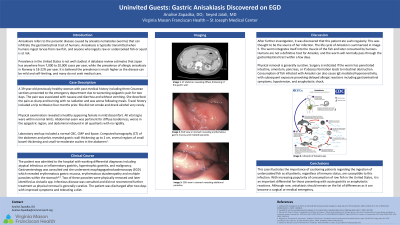Sunday Poster Session
Category: Stomach
P1692 - Uninvited Guests: Gastric Anisakiasis Discovered During EGD
Sunday, October 27, 2024
3:30 PM - 7:00 PM ET
Location: Exhibit Hall E

Has Audio

Analise Zapadka, DO
Virginia Mason Franciscan Health
Tacoma, WA
Presenting Author(s)
Award: Presidential Poster Award
Analise Zapadka, DO, Seyed Jalali, MD
Virginia Mason Franciscan Health, Tacoma, WA
Introduction: Anisakiasis refers to the parasitic disease caused by anisakis nematodes (worms) that can infiltrate the gastrointestinal tract of humans. Anisakiasis is typically transmitted when humans ingest larvae from raw fish. Prevalence in the United States is not well studied. A database review estimates that Japan has anywhere from 7,000 to 20,000 cases per year. It is believed the prevalence is much higher as the disease can be mild and self-limiting, and many do not seek medical care.
Case Description/Methods: A 39-year-old, previously healthy woman presented to the emergency department due to worsening epigastric pain and nausea for two days. She endorsed diarrhea for the duration of her illness. She described the pain as sharp and burning with no radiation and was worse following meals. Her vital signs were within normal limits and laboratory studies were unremarkable. Abdominal examination revealed diffuse tenderness, worse in the epigastric region, and abdominal rebound in all quadrants with no rigidity. Abdominal computed tomography scan revealed marked gastric wall thickening measuring up to two centimeters, several regions of small bowel thickening, and small-to-moderate ascites in the abdomen. The patient was admitted with working differential diagnoses including atypical infectious or inflammatory gastritis, hypertrophic gastritis, and malignancy. She underwent esophagogastroduodenoscopy which revealed erythematous gastric mucosa, erythematous duodenopathy and multiple parasites within the stomach. Two of these parasites were physically removed and later identified as Anisakis spp. Infectious disease was consulted and did not recommend further treatment as physical removal is generally curative. The patient was discharged after two days with improved symptoms and tolerating a diet.
Discussion: After further investigation, it was discovered that this patient ate sushi regularly. This was thought to be the source of her infection. Humans are not a definitive host for Anisakis, and the worm normally passes through the gastrointestinal tract within a few days. Physical removal is generally curative, as seen in this patient. Surgery is indicated if the worm has penetrated intestine, omentum, pancreas, or if abscess formation leads to intestinal obstruction. With increasing popularity of consumption of raw fish in the United States, it is an important differential for those presenting with acute gastritis as it can become a surgical or medical emergency.

Disclosures:
Analise Zapadka, DO, Seyed Jalali, MD. P1692 - Uninvited Guests: Gastric Anisakiasis Discovered During EGD, ACG 2024 Annual Scientific Meeting Abstracts. Philadelphia, PA: American College of Gastroenterology.
Analise Zapadka, DO, Seyed Jalali, MD
Virginia Mason Franciscan Health, Tacoma, WA
Introduction: Anisakiasis refers to the parasitic disease caused by anisakis nematodes (worms) that can infiltrate the gastrointestinal tract of humans. Anisakiasis is typically transmitted when humans ingest larvae from raw fish. Prevalence in the United States is not well studied. A database review estimates that Japan has anywhere from 7,000 to 20,000 cases per year. It is believed the prevalence is much higher as the disease can be mild and self-limiting, and many do not seek medical care.
Case Description/Methods: A 39-year-old, previously healthy woman presented to the emergency department due to worsening epigastric pain and nausea for two days. She endorsed diarrhea for the duration of her illness. She described the pain as sharp and burning with no radiation and was worse following meals. Her vital signs were within normal limits and laboratory studies were unremarkable. Abdominal examination revealed diffuse tenderness, worse in the epigastric region, and abdominal rebound in all quadrants with no rigidity. Abdominal computed tomography scan revealed marked gastric wall thickening measuring up to two centimeters, several regions of small bowel thickening, and small-to-moderate ascites in the abdomen. The patient was admitted with working differential diagnoses including atypical infectious or inflammatory gastritis, hypertrophic gastritis, and malignancy. She underwent esophagogastroduodenoscopy which revealed erythematous gastric mucosa, erythematous duodenopathy and multiple parasites within the stomach. Two of these parasites were physically removed and later identified as Anisakis spp. Infectious disease was consulted and did not recommend further treatment as physical removal is generally curative. The patient was discharged after two days with improved symptoms and tolerating a diet.
Discussion: After further investigation, it was discovered that this patient ate sushi regularly. This was thought to be the source of her infection. Humans are not a definitive host for Anisakis, and the worm normally passes through the gastrointestinal tract within a few days. Physical removal is generally curative, as seen in this patient. Surgery is indicated if the worm has penetrated intestine, omentum, pancreas, or if abscess formation leads to intestinal obstruction. With increasing popularity of consumption of raw fish in the United States, it is an important differential for those presenting with acute gastritis as it can become a surgical or medical emergency.

Figure: Image A. CT abdomen showing diffuse thickening of the gastric wall
Images B and C. EGD findings including erythematous gastric mucosa and multiple Anisakis worms
Images B and C. EGD findings including erythematous gastric mucosa and multiple Anisakis worms
Disclosures:
Analise Zapadka indicated no relevant financial relationships.
Seyed Jalali indicated no relevant financial relationships.
Analise Zapadka, DO, Seyed Jalali, MD. P1692 - Uninvited Guests: Gastric Anisakiasis Discovered During EGD, ACG 2024 Annual Scientific Meeting Abstracts. Philadelphia, PA: American College of Gastroenterology.


